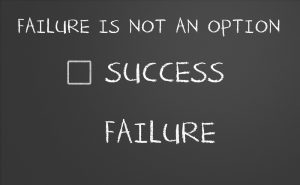” Failure is not an option,” was our rallying cry as we continued to blaze trails with our flagship product. As a forward-looking and optimistic statement of intent, I bought in. After all, I reasoned, you can’t plan to succeed if you see failure as an option. On its surface, this adage sounds powerful and is meant to be motivating. But in practice, it can be a recipe for disaster. Because the flip side of that phrase is that you must succeed all the time. And no one succeeds all the time. If failure is not an option, people develop tremendous fear and anxiety concerning their work.
Here’s how it might play out:
- There is no collaboration. No one wants to be the one who speaks up and tells the emperor that he’s not wearing any clothes. People are reluctant to tell you things that they know you don’t want to hear, even if they know that the information is important. If people speak up and get shot down, they will simply stop speaking up- unless they are a glutton for punishment. If people walk out of meetings and do more speaking outside of the meeting, you know you have a problem.
• People play it safe. In order not to fail, people will choose easy targets. They won’t stretch themselves or even try new things. After all there is no incentive for innovation if one is not allowed to fail. Remember some great ideas and inventions came out of failure ( Post-it-Notes, Viagra).
• People hide mistakes. They hide mistakes because they fear they have failed, rather than welcoming it as an opportunity to seek guidance. The longer a mistake is hidden, the greater its potential impact.
• People don’t ask for help when they need it. Like hiding mistakes, asking for help is perceived as signaling weakness, an inability to get the job done.
• People are not effectively engaged. They don’t feel confident enough to step outside their comfort zone and instead take a low risk posture. Rather than focusing on helping you meet those bodacious goals, they focus on staying safe, playing small, “keeping their heads down.” It may look like everyone is busy- they are, just not effectively.
Organizations need to recognize these obstacles to optimal risk taking and potential contributions to organizational failure. It’s not hard to imagine the impact of these behaviors in an organization. Repeated mistakes can impact the bottom line and repeated failures an organization’s reputation, further enhancing a risk-adverse environment. We learn when we share, debate and problem-solve together.
A healthy workplace encourages calculated risk taking. If we don’t set our sights high enough, we limit what we can achieve.
When we allow failure to lead us to learn, adapt, innovate, we make failure an unlikely option.

